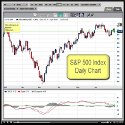This article is part of the Trend Technician Technical Analysis Basics series. Be sure to read the rest of the series.
Probably the first type of chart analysis to come into play is the analysis of area areas of support and resistance. Support is a price level at which buying increases to either pause or reverse a downtrend. Similarly resistance is a price level at which selling increase to either pause or reverse an uptrend. This sounds complex, but is really quite intuitive in practice.
For the purposes of this conversation we’ll assume we’re talking about a stock, although this applies to any traded issue. Intuitively you can imagine that various members of the market see the stock as atractive at a certain level. As the price gets lower and lower more members start to see the stock as underpriced. This effects becomes manifest at a certain price at which there doesn’t remain enough selling power to push it down and the price “bounces off” the support level. In this chart that price is roughly 87. [More]
 If you’re trading without a “stop,” you are playing Russian Roulette with your money. “Stop Loss Orders” or “stops” are orders you place with your brokers to indicate that if your position moves against you to a certain point you will exit the trade. You have a “stop price” where if the issue trades at that price or worse, the order turns into a market order to sell or buy. Many traders don’t actually place the order but have a price at which they will exit the trade, which they still call a “stop.” In fact some traders prefer not to place an actual order because they fear they will influence price execution and get “stopped out” when they wouldn’t have otherwise. Regardless of how you execute the exit, you should never enter any position without a price at which you know you’re wrong and get out of the trade.
If you’re trading without a “stop,” you are playing Russian Roulette with your money. “Stop Loss Orders” or “stops” are orders you place with your brokers to indicate that if your position moves against you to a certain point you will exit the trade. You have a “stop price” where if the issue trades at that price or worse, the order turns into a market order to sell or buy. Many traders don’t actually place the order but have a price at which they will exit the trade, which they still call a “stop.” In fact some traders prefer not to place an actual order because they fear they will influence price execution and get “stopped out” when they wouldn’t have otherwise. Regardless of how you execute the exit, you should never enter any position without a price at which you know you’re wrong and get out of the trade.
The Psychology of the Stop
The psychology of trading is fraught with peril. In many ways once the trade is on you can become fixated on making that trade work out. The problem is, when you’re doing the research and working out your trade, you’re perfectly rational. Once you’ve placed the order however, you can start lying to yourself and costing yourself money by convincing yourself to stay with a trade that’s turned against you. By always trading with a stop, you can set the extent of your trade while you’re still acting completely rationally. This can be a huge money saver. [More]
 If you’re trading without a “stop,” you are playing Russian Roulette with your money. “Stop Loss Orders” or “stops” are orders you place with your brokers to indicate that if your position moves against you to a certain point you will exit the trade. You have a “stop price” where if the issue trades at that price or worse, the order turns into a market order to sell or buy. Many traders don’t actually place the order but have a price at which they will exit the trade, which they still call a “stop.” In fact some traders prefer not to place an actual order because they fear they will influence price execution and get “stopped out” when they wouldn’t have otherwise. Regardless of how you execute the exit, you should never enter any position without a price at which you know you’re wrong and get out of the trade.
If you’re trading without a “stop,” you are playing Russian Roulette with your money. “Stop Loss Orders” or “stops” are orders you place with your brokers to indicate that if your position moves against you to a certain point you will exit the trade. You have a “stop price” where if the issue trades at that price or worse, the order turns into a market order to sell or buy. Many traders don’t actually place the order but have a price at which they will exit the trade, which they still call a “stop.” In fact some traders prefer not to place an actual order because they fear they will influence price execution and get “stopped out” when they wouldn’t have otherwise. Regardless of how you execute the exit, you should never enter any position without a price at which you know you’re wrong and get out of the trade.

